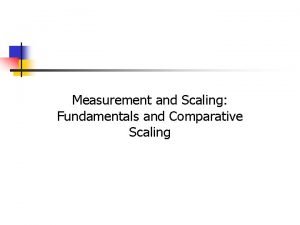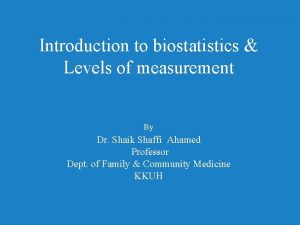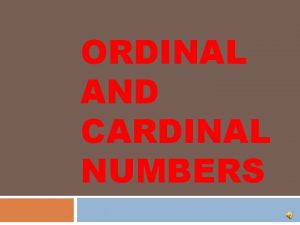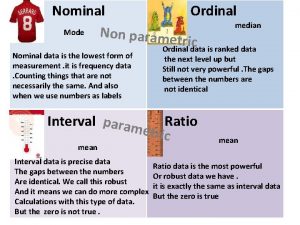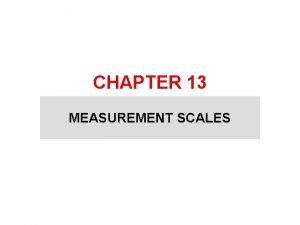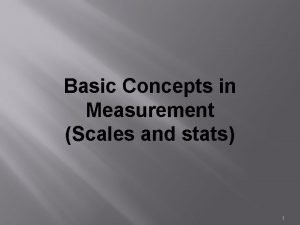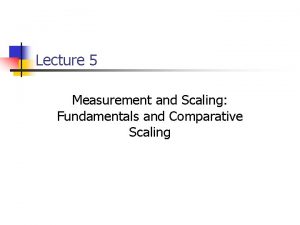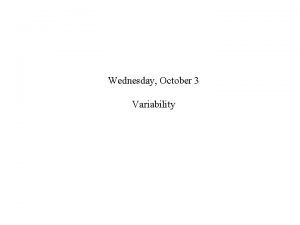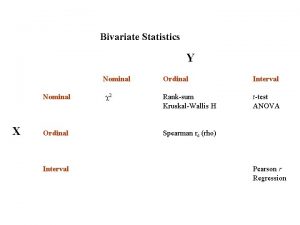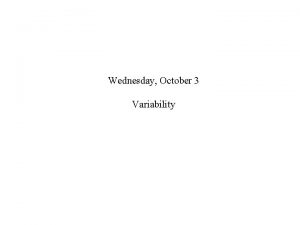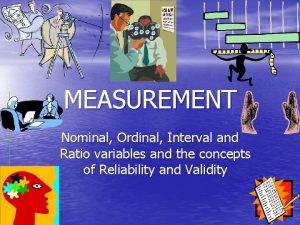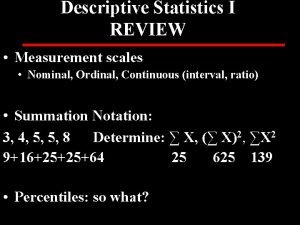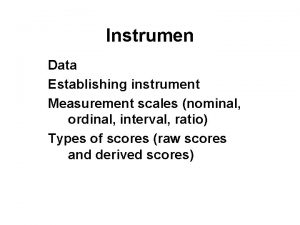Measurement of scales Classifications Nominal scale Ordinal Interval












- Slides: 12

Measurement of scales

Classifications • Nominal scale • Ordinal • Interval • ratio

Nominal scale • Least powerful level of measurement • No order • No relationship • No arithmetic origin • It is a counted data • No quantitative value • Given numbers for convenience

• These numbers does not give any meaning to place them in an order • Despite its weakness…. it is widely used • E. g: Assigned numbers in the “T “shirts of cricketers

• E, g, nominal data: color of the hair, place of living, gender….

Ordinal scale • It is used commonly in qualitative research • It is a lowest level of ordered scale • Here ranks are assigned • Only ranking highest and lowest is possible • It wont tell rank one how many times better than rank 2 • Only it tells who is on the top and who is at the bottom of the scale • Comparison cannot be made • So statement one can do is… greater than and lower than

e. g. ordinal scale • Customer satisfaction survey on products • Satisfaction towards nursing care • Discomfort in the classrooms • Happiness expressed by the children

Interval scale • A rule is established to make the units equal • Here there is arbitrary zero • But no absolute zero or true zero…this is a greater limitation of this scale • It does not have a capacity to measure the complete absence of a trait hense , they are powerful than ordinal scales • Here ‘F’test , t test is generally used for statistical significance • SD is used as a measure of dispersion. • E. g for the interval scale: temperature

• Interval scales are numeric scales in which we know not only the order, but also the exact differences between the values. • E. g TEMPERATURE.

Ratio scale • Has true zero or absolute zero • zero says completely absence of measure • E. g zero length, weight, distance • Geometric and harmonic means, central of tendency and coefficient of variation are used for analysis

• These variables can be meaningfully added, subtracted, multiplied, divided (ratios).

End • The least precise scale is nominal scale • Most precise scale is ratio • As per nature of the variable the researcher need to select the scale of measurement.
 Nominal scale of measurement
Nominal scale of measurement Nominal data examples
Nominal data examples Nominal and ordinal scale
Nominal and ordinal scale Nominal ordinal intervalo razon
Nominal ordinal intervalo razon Nominal ordinal cardinal
Nominal ordinal cardinal Nominal ordinal
Nominal ordinal Nominal vs ordinal data
Nominal vs ordinal data Nominal, ordinal, discrete, continuous
Nominal, ordinal, discrete, continuous 10 ejemplos de escala de intervalo
10 ejemplos de escala de intervalo Cipriones
Cipriones 4 scales of measurement
4 scales of measurement Magnitude is the property of “moreness”.
Magnitude is the property of “moreness”. Scales of measurement
Scales of measurement
